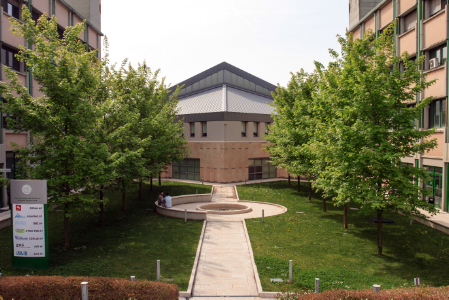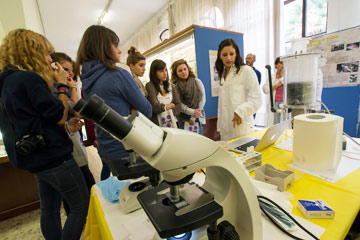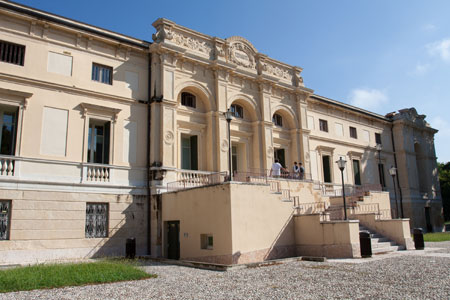Obiettivo della ricerca eseguita
The first aim of our project CHIRALAB was to obtain: A) new luminescent chiral molecules and materials, with high circularly polarized luminescence, CPL; B) new light absorbers with high circular dichroism, CD; C) new bioassays, based on chiroptical switches, i.e. receptors which change their CD or CPL in response to their binding with a biologically relevant analyte. Point A) was addressed with chiral lanthanide complexes and organic emitters organized in chiral supramolecular structures; some Ln(III) ions feature optimal CPL in the visible (Eu, Sm, Tb); chiral arrangement of chromophoric ligands can determine large CD and CPL (in the UV, vis and NIR). With these latter systems, we addressed also point B). For point C) we used Ln(III) together with other systems with an exchangeable ligation site, where the bioanalyte determined the chiroptical switch, allowing for quantitative analyses. With the systems prepared in A) and B), we designed and fabricated optoelectronic systems able to discriminate circularly polarized (CP) light: CP-OLED and CP-detectors. The ultimate goal of CHIRALAB was to set up prototype of revolutionary instrument for chiral bioanalyses (point C) based on plastic electronics
Risultati ottenuti durante il progetto
We took advantage of biomolecular homochirality for several separate objectives finally converging in an ambitious goal: to set up a revolutionary prototype instrument for bioanalyses based on chiroptical spectroscopies, employing only modern optoelectronic devices, i.e. avoiding expensive items for producing and detecting circularly polarized (CP) and monochromatic light (sources, polarization, modulators, detectors). We constituted a multidisciplinary team with complementary expertise covering synthetic organic and inorganic chemistry, spectroscopy, characterization of molecules and materials and device fabrication and testing. The project developed on the following lines.
We designed and synthetized complexes of trivalent lanthanide ions (of Eu, Tb, Yb and Sm) with bright emission in the visible and infrared, which in a chiral environment gave rise to strong circularly polarized luminescence (CPL). Thanks to our solid understanding of the phenomenon, we prepared new chiral Ln (III) complexes with high CPL, which were used for fabricating CP-light sources, in particular innovative CP-OLEDs. Within the project, we design, synthesized, and characterized, also from a spectroscopic point of view, several heteroleptic complexes containing 1,2-trans-diaminecyclohexane (DACH)-based polydentate ligand and good chromophoric antennae, such as tta = 2-thenoyltrifluoroacetyl-acetonate and several 3-oxo-4-hydroxy-coumarin-based molecules which are substituted at 3 position. The polydentate ligand gave the required chirality for the CPL activity and the antennae ensure a strong emission intensity. The prepared Tb and Eu-based complexes exhibited a strong CPL emission with good overall quantum yield (up to 70%). Another family of heteroleptic complexes we designed was the one constituted by the chiral pyridine bis-oxazoline (PyBox) molecules and tta. Also in this case an efficient CPL emission was observed.
Furthermore, organic-conjugated molecules decorated with chiral groups selected from natural single enantiomer compounds (chiral pool) formed supramolecular chiral structures, which afforded obtain high broadband CPL. The very same ordered layers of organic -conjugated dyes were evaluated for CD and the best candidates (high CD dissymmetry ratio) will be used for designing and making CP-sensitive detectors, which will be used to recognize and quantify CP-light arising from the analytical assays we shall develop. Among the molecules sensitized and characterized from a spectroscopic point of view, we obtained: A) chiral diketopyrrole[3,4-c]pyrrolic (DPP)-based absorbers characterized by different substitution on the lactamic nitrogens or on the conjugate backbone. B) chiral perylenediimide-based substituted molecules; C) chiral benzo[c][1,2,5]thiodiazole with different substituents; D) chiral and substituted croconaines and E) chiral 3-oxo-4-hydroxy-coumarin derivatives and F) chiral cyanines. As it is well known that the aggregation of these molecules in the solid state can strongly affect the chiroptical properties, the aforementioned substitutions were crucial in order to control aggregation. Most of these molecules showed interesting absorption and emission properties in the near-infrared (NIR) spectral region. Also new, solvent-free, synthetic protocols have been optimized for the synthesis of some of these chiral and highly-conjugated organic molecules.
As for the design of a chiroptical switch, we focused our attention on chiral lanthanide complexes. A chiroptical switch is a system with CPL or CD spectra changing in response to an external stimulus. Most typical is the situation where an achiral reporter becomes chiral upon interaction with a substrate and the CD or CPL spectra go from 0 to some non-0 signal. We developed CPL and CD switches in the visible, where the stimulus was constituted by lactic acid (a very relevant bioanalyte). CPL and/or CD signal intensity will provide quantitative assessment of the analyte. There are already numerous CD methods for quantification of lactic acid, while only a few using CPL. We developed a new assay sensitive not only to the analyte, but also on its configuration, based on Tb CPL in the green. In this context, we also prepared two Eu(III)-based chiral complexes containing DACH-based ligands in which a pyridine or isoquinoline fragment is present. Both molecules interact with a serum protein, such as BSA (Bovine Serum Protein), hydrogen carbonate and citrate. All these analytes are the main molecules contained in a typical extracellular fluid. For the Eu(III) complex characterized by the presence of the iso-quinoline fragment, we observed a selective optical response towards citrate in a solution simulating an extracellular fluid. Unfortunately, in all the sensing experiments the CPL activity cannot be used to detect the presence of the aforementioned target analytes, since no significant variation of this chiroptical activity has been obtained. All the complexes were characterized from a thermodynamic point of view (potentiometric, spectrophotometric and calorimetric titration) in order to determine their stability constants. With the same approach, the probe/analyte interaction was investigated and the affinity constant of the formation of the adducts was determined. Optimized CP-OLEDs based on chiral emitters (Eu(III) complexes) produced in the project, showed a maximum luminance close to 300 cd/m2, electroluminescence dissymmetry values in the range 0.51-0.63 and external quantum efficiency in the range 1%. CP-OLED critical factors affecting the total and CP-electroluminescence were analyzed: active layer formulation and thickness, cathode transparency, device architecture.
A prototype of CP photosensitive device (organic photodetector) was fabricated based on polymer donor/non-fullerene acceptor mixture with a chiroptical activity achieved by adding a chiral inducer to the blend. The preliminary characterization showed that under illumination of left- and right-handed CPL. The photodiode dissymmetry value is about 0.04 by biasing in the range -2V to 0V.
All the prototypes of light sources and photodetectors were fabricated by solution methods.
Dispositivi avanzati prodotti durante il progetto:
6 tipologie di dispositivi CP elettroluminescenti (CP-OLED) costituiti da complessi eterolettici di Eu(III) con leganti chirali a base PyBox e tta come antenna.
1 tipologia di CP fotodiodi ad eterogiunzione organica polimerica non-fullerenica con induttore di chiralità nello strato attivo.
Seguiteci sull’account social del progetto:
“X” @ChiralabPrin







